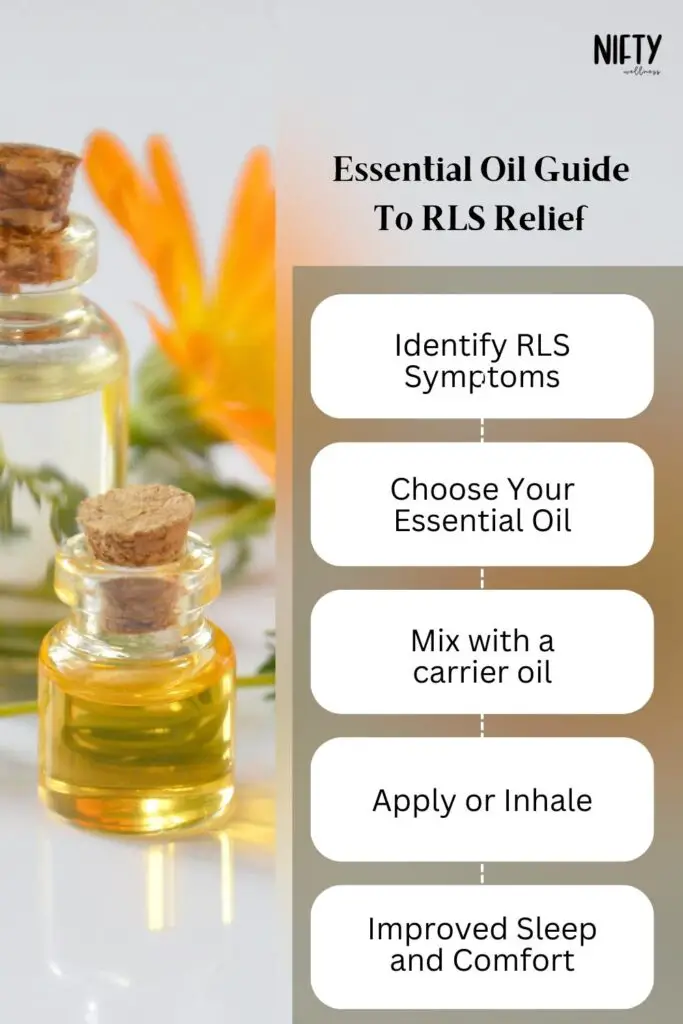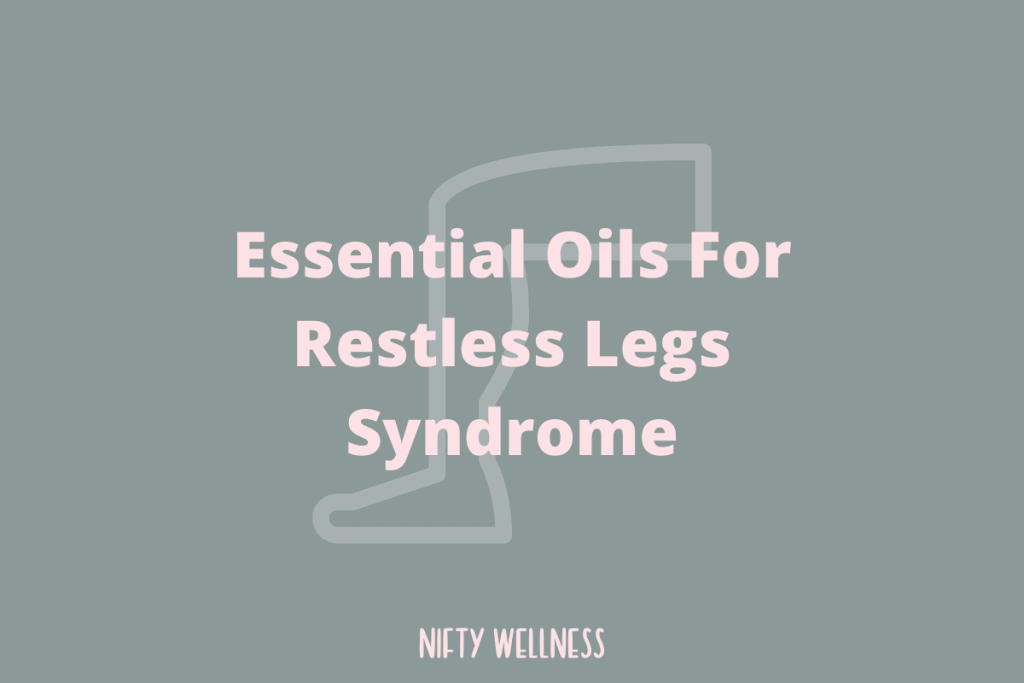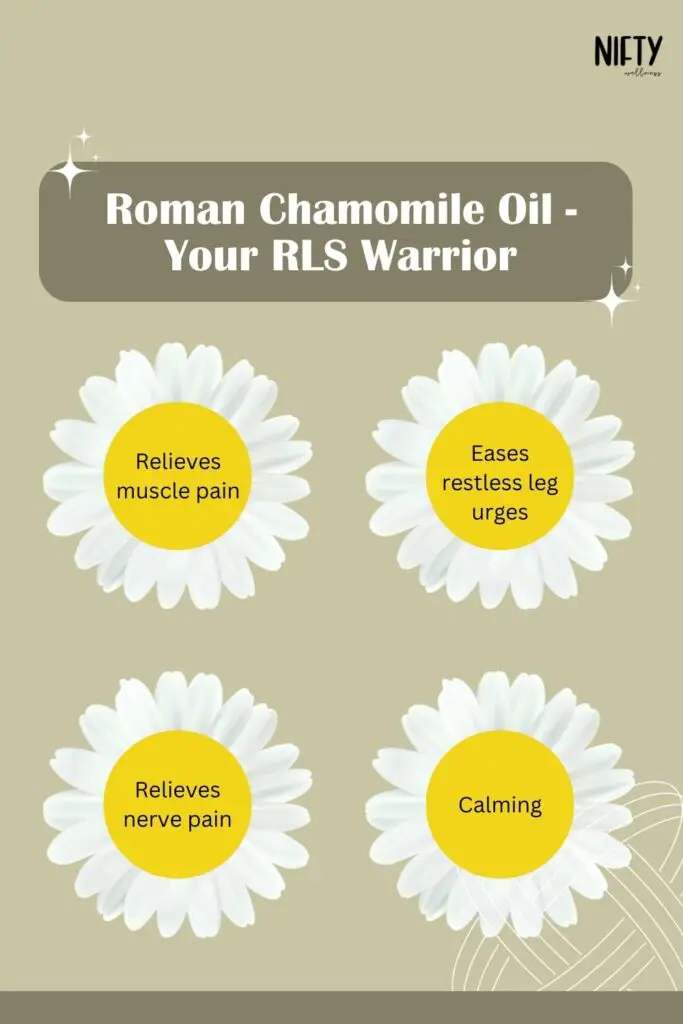Imagine a night of tranquility, where the world around you is at rest, and you are nestled in the comfort of your bed. But suddenly, an irresistible urge disrupts the peace – a tingling sensation in your legs, an ache that refuses to be ignored. Restless Legs Syndrome (RLS), also known as Willis-Ekbom disease, is a neurological enigma that paints sleepless nights with discomfort. This condition instigates the overwhelming desire to move your legs and takes centre stage when rest beckon.
The symphony of discomfort, itching, and aching can be overwhelming, making RLS challenging for those seeking peaceful slumber. Let’s embark on a journey into the world of RLS and discover how essential oils for restless legs can offer respite from this nightly ordeal.
What Is Restless Legs Syndrome?


Restless Legs Syndrome (RLS), also commonly known as Willis-Ekbom disease, is a neurological disorder that causes unpleasant sensations in the legs and an irresistible urge to move them.
This urge is difficult to control and can often happen in the late afternoon or evening but is typically most severe during sleep or moments of rest and relaxation.
For this reason, RLS is considered a sleeping disorder since the symptoms are triggered by rest and lack of movement.
These urges can also occur during moments of inactivity or when someone has been sitting for an extended period of time, such as sitting on an airplane. Those with restless legs syndrome find that moving the legs or walking relieves the discomfort and urge.
However, once these movements stop, the sensations reoccur. For this reason, RLS is also considered to be a movement disorder.
However, according to the National Institute of Neurological Disorders and Stroke, RLS is best described as a neurological sensory disorder because the symptoms are produced within the brain itself.
Symptoms Of Restless Legs Syndrome

Perhaps the most common sign or symptom of RLS is the irresistible desire to move, which is accompanied by strong, uncomfortable sensations in the lower limbs.
These sensations are difficult for those with RLS to describe but have been likened to feelings of pulling, aching, throbbing, itching, or crawling.
To minimize this discomfort, people with restless legs syndrome will keep their legs constantly moving. Because restless legs syndrome is so troublesome at night and during periods of rest, those with RLS will find it difficult to fall or stay asleep.
This can result in daytime drowsiness, fatigue, sleep deprivation, and other related issues that profoundly impact physical, mental, and emotional health.
(The unique Hojicha tea might also help, read more about it – in a new tab.)
Are Essential Oils Good For Restless Legs Syndrome?


Restless legs syndrome can be treated by relieving some of its symptoms. Therefore, essential oils can be beneficial tools for controlling RLS symptoms and providing temporary relief.
Certain oils are known to have calming antispasmodic and analgesic properties. Other oils could influence and boost mood, which could be beneficial to those with RLS as there are connections between unbalanced dopamine levels in the brain and RLS symptoms.
Essential oils can also be implemented into the lifestyle changes and activities that can help provide relief for those with restless legs syndrome, such as maintaining a regular sleeping pattern, massaging and stretching the legs, taking a warm bath, yoga, meditation, or using a heat or ice pack.
Treat yourself to the nourishing power of the top post-shave oils that promise to rejuvenate your skin like never before by reading our latest blog “The Ultimate Guide To Oils For After Shaving: Achieve a Smooth and Nourished Skin“.
Essential Oils For Restless Legs Syndrome

Lavender Essential Oil
Lavender essential oil is one of the best oils for relieving RLS symptoms due to its analgesic and antispasmodic properties (aka it relieves muscle pains, spasms, and achiness).
These properties can be utilized by combining a few drops of lavender oil with a carrier oil and then massaging these oils onto the legs, as one 2015 study found.
Lavender is also an excellent oil to use before bed or other times of rest as it calms the mind and body and promotes a night of deeper sleep.
How to use: Lavender essential oil can be combined with a carrier oil like jojoba or grapeseed oil and massaged into the legs to relieve symptoms. A few drops of this oil can also be added to a warm or hot bath. At night, lavender can be diffused near the bedside to promote better sleep.
Roman Chamomile Essential Oil

Known for its calming capabilities, Roman chamomile is a fantastic oil for restless legs syndrome relief.
Roman chamomile’s analgesic, antispasmodic, and anti-neuralgic (meaning that it can temporarily relieve nerve pain) properties make it a stand-out oil for RLS.
How to Use: A few drops of Roman chamomile can be added to a warm or hot bath. Alongside relaxing oils like lavender and vetiver, Roman chamomile can be diffused at nighttime or combined with a carrier oil and used as a massage treatment.
Bergamot Essential Oil
Bergamot is a calming, mood-boosting fragrance that can have aromatherapy benefits on those with RLS.
In addition, bergamot’s natural analgesic, antispasmodic, and calming properties can relax the muscles and provide temporary relief from aches, pains, and spasms.
How to Use: Bergamot can be diffused alongside jasmine and lavender to boost mood. Bergamot can also be added to a hot bath to soothe muscles or combined with a carrier oil for a nourishing massage oil.
Rosemary Essential Oil
Rosemary is a warming, calming oil that can provide relief for those with RLS.
In addition to its warming, calming properties, rosemary is also analgesic and antispasmodic, which is essential for treating muscle aches, pains, and spasms.
How to Use: A few drops of rosemary, along with lavender, can be added into a hot bath to provide relief for aching, spasming muscles. Rosemary can also be combined with other essential oils such as vetiver and a carrier oil to target and soothe the lower body.
Peppermint Essential Oil

Peppermint essential oil is well-known for its ability to calm and cool muscle aches and pains due to its high concentration of menthol. It also has natural antispasmodic and analgesic properties that can treat aches, pains, and spasms. This invigorating essential oil brings a refreshing burst of relief, making it a valuable addition to your toolkit for soothing discomfort and muscle distress.
How to Use: Peppermint can be combined with a carrier oil for a cooling massage rub. A few drops of peppermint can also be added to a cold, wet towel to create a cold compress.
Alternatively, you can dilute a few drops of peppermint essential oil in a spray bottle with water for a refreshing, cooling mist that can provide quick relief when sprayed on the affected areas.
Jasmine Essential Oil
Jasmine is a sweet, floral scent that can boost mood and relieve pain. Its inherent analgesic and antispasmodic properties treat RLS pain, aches, urges, and spasms. This soothing fragrance isn’t just a delight for the senses but also a balm for your restless legs. Combine it with a carrier oil for a calming massage or add a few drops to your warm bath to target those restless urges and provide a relaxing soak.
How to Use: A couple drops of jasmine essential oil can be added to a warm or hot bath to target restless urges. Jasmine, alongside bergamot or sweet orange, can be diffused during the day to boost mood. A few drops of jasmine can also be combined with a carrier oil to create a soothing, pleasing massage oil.
Vetiver Essential Oil
Vetiver essential oil is a great bedtime oil that can calm the mind and body and promote deeper, better sleep. It also has antispasmodic properties that can soothe restless muscle urges.
In addition, vetiver promotes healthy blood circulation, providing relief for muscle aches and pains.
How to Use: Add a few drops of vetiver into a warm or hot bath. Vetiver can also be diffused along with lavender by the bedside at night to promote sounder sleep. To use vetiver for massage, combine a few drops with a carrier such as jojoba or grapeseed oil.

Sweet Marjoram Essential Oil
Marjoram is a fantastic oil that can be used to mitigate RLS symptoms due to its analgesic, antispasmodic, and sedative properties. These properties calm the mind and body and provide temporary relief from muscle aches, pains, and spasms. Sweet Marjoram Essential Oil also acts as a gentle sedative, promoting a sense of relaxation and calm, which can be particularly beneficial for those with restless legs.
How to Use: Sweet marjoram essential oil can be combined with a carrier oil and used for leg massage, or a few drops can be added into a warm or hot bath to provide relief. To maximize its soothing properties, you can diffuse a few drops of Sweet Marjoram essential oil alongside other relaxing oils in your bedroom to create a peaceful environment conducive to better sleep.
Check out our latest blog Fragrance Oils vs Essential Oils: Which One is Right for You? Uncover the secrets to choosing the perfect scent for your needs.
Conclusion
As we conclude our exploration into the world of Restless Legs Syndrome and the soothing touch of essential oils, it’s essential to remember that relief is within your grasp. Those inexplicable urges and discomfort can find solace in the calming embrace of lavender, Roman chamomile, bergamot, rosemary, peppermint, jasmine, vetiver, and sweet marjoram essential oils for restless legs. With their analgesic, antispasmodic, and mood-enhancing properties, these oils are not mere fragrances; they are nature’s remedy to help you rediscover restful nights.
Restless Legs Syndrome may cast its shadow, but you hold the power to brighten the path to peaceful sleep with essential oils for restless leg syndrome. Whether through warm baths, massages, or diffusing these oils, your journey to tranquility is well within reach. So, explore the world of essential oils, and let the aroma of relief guide you toward serenity. Rest well, dear reader. Your nights are yours to reclaim.
Frequently Asked Questions

What Essential Oil Is Best For Restless Legs?
When choosing an essential oil for restless legs syndrome, you want to look for oils that have calming, antispasmodic, analgesic properties that can target aches, pains, and spasms, such as peppermint, chamomile, and rosemary.
However, lavender essential oil is the most well-studied oil when it comes to improving RLS symptoms.
What Causes Restless Legs Syndrome?
For the most part, what causes RLS is unknown. Though experts have found that genetics and environmental triggers have a profound effect on whether someone will have RLS. In fact, more than 40 percent of all cases have had a genetic predisposition.
What Is The Prognosis For People With Restless Legs Syndrome?
Unfortunately, RLS is a lifelong condition that currently has no cure. Its symptoms and effects can be minimized through therapies, lifestyle changes, and other treatments. Some people with restless legs syndrome have gone into remission periods, but symptoms do eventually reappear.
What Triggers Restless Legs Syndrome?
For people with RLS, a lack of movement can trigger spasmodic urges and other related symptoms. This is especially true at night where the sitting, laying down, and otherwise lack of movement can cause severe symptoms.
